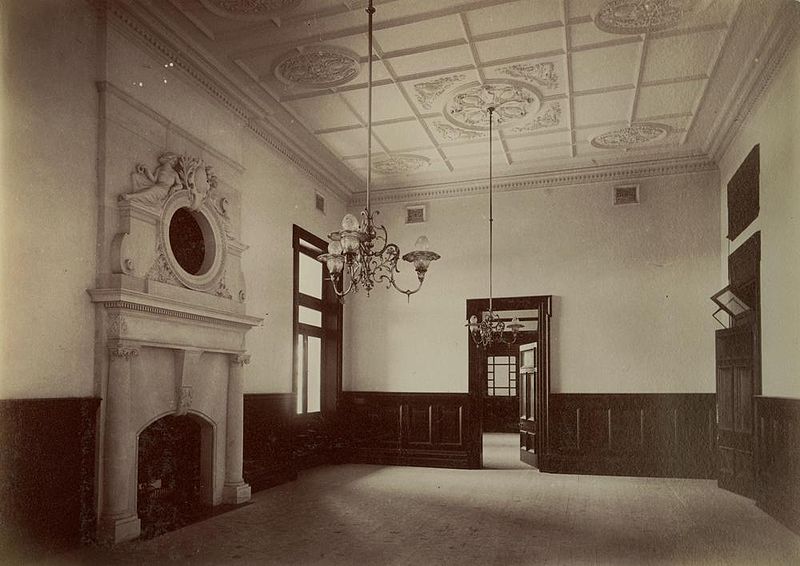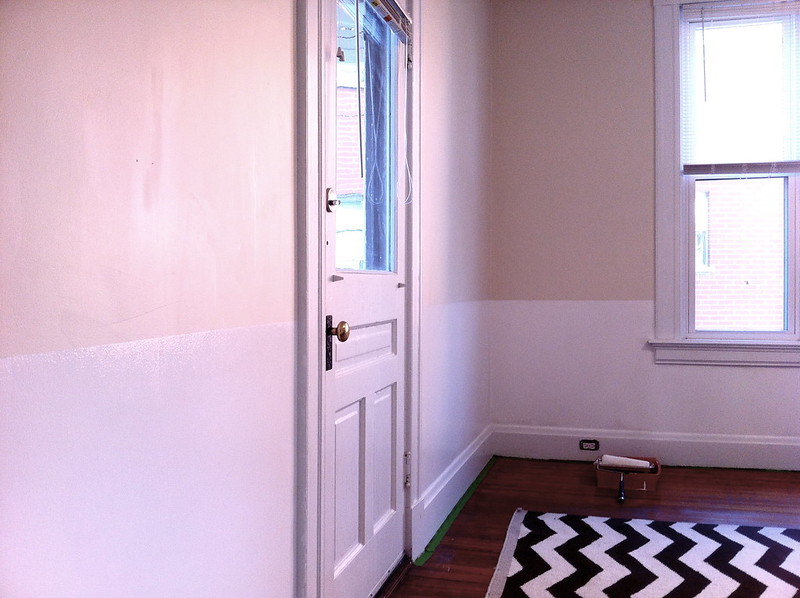Wainscoting

|
| This image of the Interior of the Lands and Survey building, ca. 1904 shows the reception room with a large marble fireplace embellished with bas relief statuary. The pressed ceiling has raised floral motifs and the bottom portion of the room has dark timber panelled wainscoting. |
Contents |
[edit] Introduction
Wainscoting is a type of wall panel that is both functional and decorative.‘To wainscot’ is to line a wall with timber, which was the original material used for wainscoting, although it is now available in other materials. Wainscoting is typically found on the lower portion of an interior wall and is often used in stairways both to protect the wall and to give the impression of spaciousness.
[edit] History
The term wainscoting was derived from a type of timber board fashioned as wallcovering out of older, slowly grown, knot-free oak trees.
The application of wainscoting was commonly introduced in the 18th century, when it was used to protect walls and provide additional insulation. It also helped decrease the impact of rising damp that could occur in some types of walls. It is now used primarily for decorative purposes.
Wainscoting was originally used in floor to ceiling applications, but was later more commonly applied to just the lower portion of walls. The use of oak decreased over the years, and other types of timber became more common choices.
[edit] Application
Wainscoting is typically constructed from materials that have been fitted with tongue and groove edges. However, modern techniques make it possible to create larger, prefabricated units of customised sizes, so that fewer, or no joints are required.

|
| This photo illustrates a faux wainscoting project in progress. |
Faux wainscoting is a technique that creates the illusion of authentic panels through the careful application of moulding and paint. Chair rail and box moulding are commonly used for this purpose, although it is possible to create a similar treatment simply through the use of paint that is either separated by a single rail or a difference in colours or textures.
[edit] Related articles on Designing Buildings Wiki
Featured articles and news
RTPI leader to become new CIOB Chief Executive Officer
Dr Victoria Hills MRTPI, FICE to take over after Caroline Gumble’s departure.
Social and affordable housing, a long term plan for delivery
The “Delivering a Decade of Renewal for Social and Affordable Housing” strategy sets out future path.
A change to adoptive architecture
Effects of global weather warming on architectural detailing, material choice and human interaction.
The proposed publicly owned and backed subsidiary of Homes England, to facilitate new homes.
How big is the problem and what can we do to mitigate the effects?
Overheating guidance and tools for building designers
A number of cool guides to help with the heat.
The UK's Modern Industrial Strategy: A 10 year plan
Previous consultation criticism, current key elements and general support with some persisting reservations.
Building Safety Regulator reforms
New roles, new staff and a new fast track service pave the way for a single construction regulator.
Architectural Technologist CPDs and Communications
CIAT CPD… and how you can do it!
Cooling centres and cool spaces
Managing extreme heat in cities by directing the public to places for heat stress relief and water sources.
Winter gardens: A brief history and warm variations
Extending the season with glass in different forms and terms.
Restoring Great Yarmouth's Winter Gardens
Transforming one of the least sustainable constructions imaginable.
Construction Skills Mission Board launch sector drive
Newly formed government and industry collaboration set strategy for recruiting an additional 100,000 construction workers a year.
New Architects Code comes into effect in September 2025
ARB Architects Code of Conduct and Practice available with ongoing consultation regarding guidance.
Welsh Skills Body (Medr) launches ambitious plan
The new skills body brings together funding and regulation of tertiary education and research for the devolved nation.
Paul Gandy FCIOB announced as next CIOB President
Former Tilbury Douglas CEO takes helm.
UK Infrastructure: A 10 Year Strategy. In brief with reactions
With the National Infrastructure and Service Transformation Authority (NISTA).























